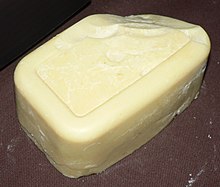 Raw cocoa butter | |
| Fat composition | |
|---|---|
| Saturated fats | |
| Total saturated | 57–64%: stearic acid (24–37%), palmitic acid (24–30%), myristic acid, (0–4%), arachidic acid (1%), lauric acid (0–1%) |
| Unsaturated fats | |
| Total unsaturated | 36–43% |
| Monounsaturated | 29–43%: oleic acid (29–38%), palmitoleic acid (0–2%) |
| Polyunsaturated | 0–5%: linoleic acid (0–4%), α-Linolenic acid (0–1%) |
| Properties | |
| Food energy per 100 g (3.5 oz) | 3,699 kilojoules (884 kcal)[1] |
| Melting point | 34.1 °C (93.4 °F), 35–36.5 °C (95.0–97.7 °F) |
| Solidity at 20 °C (68 °F) | solid |
| Refractive index | 1.44556–1.44573 |
| Iodine value | 32.11–35.12, 35.575 |
| Acid value | 1.68 |
| Saponification value | 191.214, 192.88–196.29 |
Cocoa butter, also called theobroma oil, is a pale-yellow, edible fat extracted from the cocoa bean (Theobroma cacao). It is used to make chocolate, as well as some ointments, toiletries, and pharmaceuticals.[2] Cocoa butter has a cocoa flavor and aroma. Its melting point is slightly below human body temperature. It is an essential ingredient of chocolate and related confectionary products. Cocoa butter does not contain butter or other animal products; it is vegan.[3]
- ^ "Cocoa butter amounts converter". Convert-to.com. 15 August 2011. Retrieved 3 November 2016.
- ^ "Cocoa butter". Encyclopædia Britannica. July 1998. Retrieved 10 September 2007.
- ^ Adams, Ashley (12 August 2019). "Is Cocoa Butter Vegan and Dairy-Free?". The Spruce Eats. Dotdash Meredith. Retrieved 30 January 2024.